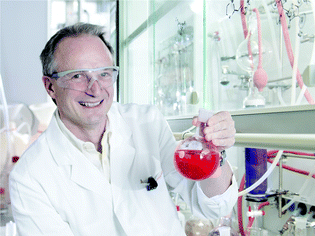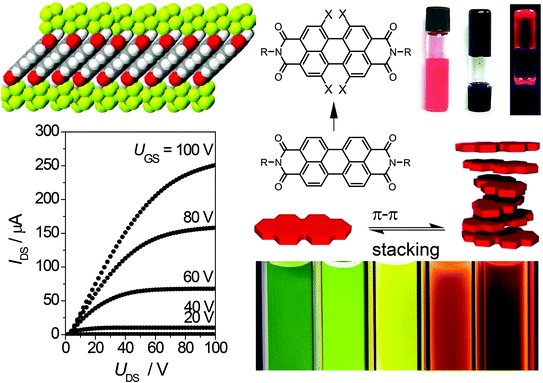Organic Chemistry Frontiers welcomes Frank Würthner as an Associate Editor
Universität Würzburg, Institut für Organische Chemie & Center for Nanosystems Chemistry, Am Hubland, 97074 Würzburg, Germany. E-mail: wuerthner@chemie.uni-wuerzburg.de; Web: http://www-organik.chemie.uni-wuerzburg.de/en/homepage/ Web: http://www.nanosystems-chemistry.uni-wuerzburg.de/home/ Tel: +49-931-3185340
The Würthner group's unique approach to functional molecular materials has always been based on supramolecular concepts. We have demonstrated that hydrogen bonding can be utilized to direct dye assembly from H- into J-aggregates to afford exceptional fluorescence properties as well as to construct supramolecular p/n-heterojunctions. Furthermore, we were the first to reveal the formation of dimer aggregates of dipolar dyes by dipole–dipole interactions in solution and to utilize this particular supramolecular motif for the application of these unconventional organic semiconductor molecules in organic transistors and solar cells. We were also among the first groups to elucidate kinetic self-assembly pathways for functional materials – nanofibers and organogels – and recently to demonstrate living supramolecular polymerization for an organogelator molecule.
Who or what inspired you to conduct research in functional organic materials?
I was always attracted to the idea of designing molecules for interesting practical applications. Thus after my graduation in Stuttgart and postdoctoral time at MIT, it was difficult to decide between a career in industry or academia. In fact, I spent almost two years in industrial research at BASF with the goal of utilizing the knowledge acquired during my doctoral studies for the development of functional dyes for nonlinear optics, electroluminescence, and non-impact printing. However, I was equally fascinated by the advanced level of functionality found in nature, as accomplished upon self-assembly of molecular building blocks, and ultimately turned back to academia to work on supramolecular materials and in particular on dye assemblies.What do you enjoy most about research?
I enjoy the unexpected discovery and the chance to work with young and highly motivated students and postdocs, who now assemble in my group from places all over the world. I indeed consider it a privilege that scientific globalization during the last ten years enabled me to enter exciting new research fields by building teams of experts from different areas and different countries to tackle scientific challenges beyond conventional organic chemistry.If you were not a chemist, which career would you choose?
Probably I would have chosen to become an architect. I grew up in a medium-sized town which did not offer jobs for chemists. Thus, the idea to become a chemist was in high school still more like a dream, becoming an architect would have been the more rational decision. Now, I construct supramolecular architectures, combining both on the molecular level.How do you usually spend your time outside research work?
I like to travel to foreign countries and to experience their cultures (often connected to business trips), to spend time in the mountains hiking, skiing or climbing (the latter in particular with my son), and to enjoy classical music in concerts and the opera (in particular with my wife).Publication highlights
F. Würthner, C. Thalacker and A. Sautter, Adv. Mater., 1999, 11, 754–758.Hierarchical Organization of Functional Perylene Chromophores to Mesoscopic Superstructures by Hydrogen Bonding and π–π-Interactions.
F. Würthner, C. Thalacker, S. Diele and C. Tschierske, Chem. – Eur. J., 2001, 7, 2245–2253.
Fluorescent J-type Aggregates and Thermotropic Columnar Mesophases of Perylene Bisimide Dyes.
F. Würthner, S. Yao, T. Debaerdemaeker and R. Wortmann, J. Am. Chem. Soc., 2002, 124, 9431–9447.
Dimerization of Merocyanine Dyes. Structural and Energetic Characterization of Dipolar Dye Aggregates and Implications for Nonlinear Optical Materials.
F. Würthner, Chem. Commun., 2004, 1564–1579 (Feature Article).
Perylene bisimide dyes as versatile building blocks for functional supramolecular architectures.
F. Würthner, Z. Chen, F. J. M. Hoeben, P. Osswald, C.-C. You, P. Jonkheijm, J. van Herrikhuyzen, A. P. H. J. Schenning, P. P. A. M. van der Schoot, E. W. Meijer, E. H. A. Beckers, S. C. J. Meskers and R. A. J. Janssen, J. Am. Chem. Soc., 2004, 126, 10611–10618.
Supramolecular p-n-Heterojunctions by Co-Self-Organization of Oligo(p-phenylene Vinylene) and Perylene Bisimide Dyes.
T. E. Kaiser, H. Wang, V. Stepanenko and F. Würthner, Angew. Chem., Int. Ed., 2007, 46, 5541–5544.
Supramolecular Construction of Fluorescent J-Aggregates Based on Hydrogen-Bonded Perylene Dyes.
X. Zhang, S. Rehm, M. Safont-Sempere and F. Würthner, Nat. Chem., 2009, 1, 623–699.
Vesicular perylene dye nanocapsules as supramolecular fluorescent pH sensor systems.
M. Gsänger, J. H. Oh, M. Könemann, H. W. Höffken, A.-M. Krause, Z. Bao and F. Würthner, Angew. Chem., Int. Ed., 2010, 49, 740–743.
A Crystal-Engineered Hydrogen-Bonded Octachloroperylene Diimide with a Twisted Core: An n-Channel Organic Semiconductor.
T. He, M. Stolte, C. Burschka, N. H. Hansen, T. Musiol, D. Kälblein, J. Pflaum, X. Tao, J. Brill and F. Würthner, Nat. Commun., 2015, 6, 1–9.
Single-Crystal Field-Effect Transistors of New CI2-NDI Polymorph Processed by Sublimation in Air.
S. Ogi, V. Stepanenko, K. Sugiyasu, M. Takeuchi and F. Würthner, J. Am. Chem. Soc., 2015, 137, 3300–3307.
Mechanism of Self-Assembly Process and Seeded Supramolecular Polymerization of Perylene Bisimide Organogelator.
| This journal is © the Partner Organisations 2015 |


